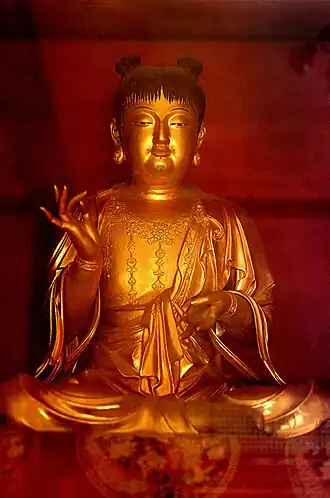Wooden Seated Child Manjusri of Sangwonsa Temple
| Wooden Seated Statue of the Child Mañjuśrī of Sangwonsa Temple | |
|---|---|
 | |
| Artist | Unknown royal court artisans |
| Year | 1466 |
| Type | Gilt-wood statue |
| Owner | Sangwonsa, Jogye Order of Korean Buddhism |
The Wooden Seated Statue of the Child Mañjuśrī of Sangwonsa Temple (Korean: 상원사 목조문수동자좌상; Hanja: 上院寺 木彫文殊童子坐像) is a Korean Buddhist statue located at Sangwonsa on Mount Odae in Pyeongchang, Gangwon Province. Carved from wood and depicting the bodhisattva Mañjuśrī in the form of a child, it has been designated as as the 221st National Treasure of South Korea and is celebrated not only for its exceptional artistic merit but also for its direct connection to a famous royal legend and the historical verification provided by documents discovered within it.[1]
Description
The statue portrays the bodhisattva Mañjuśrī, a figure associated with transcendent wisdom in Mahāyāna Buddhism, in the rare form of a seated child. It measures approximately 69 centimeters in height and is carved from a single block of wood. The serene expression, gentle smile, and finely rendered robes exemplify the delicate aesthetic sensibilities of the early Joseon period.[2]
Legend
The statue's creation is directly linked to a well-known story involving King Sejo (r. 1455–1468), who was a devout Buddhist. During his later years, King Sejo suffered from a severe and painful skin disease that no royal physician could cure. Believing it to be karmic retribution for his usurpation of the throne from his nephew, King Danjong, he made pilgrimages to many famous temples to pray for healing.[2]
According to the legend, while visiting Sangwonsa Temple, Sejo was bathing in a nearby stream when a young boy (dongja) appeared and offered to scrub his back. As the boy washed him, the king felt his skin being soothed. He confided in the boy that his ailment was a great secret, to which the boy replied, "You must also promise never to tell anyone that you have seen Mañjuśrī Bodhisattva (known as Munsu Bosal in Korean)." With those words, the boy vanished. The king's disease was miraculously cured.[3] In gratitude for this divine intervention, King Sejo commissioned the creation of this statue in the image of the child Bodhisattva who had healed him. It is also popularly believed that the statue's face was modeled after Sejo's first son, Crown Prince Uigyeong, who had died young at the age of 19.[4]
Discovery of historical evidence
For centuries, the connection between the statue and King Sejo was regarded as a legend. However, during conservation work conducted in July 1984, a concealed compartment within the statue was uncovered, revealing a collection of votive offerings known as bokjang. Among the contents were over 20 historical documents and textiles, providing valuable insight into the statue’s provenance.[5]
The most significant item was a copy of the Worin seokbo (월인석보; 月印釋譜), a major Buddhist text compiled under the patronage of King Sejo. According to the colophon accompanying the text, the restoration of Sangwonsa Temple took place in the same year, and the child Mañjuśrī statue housed in the temple was commissioned in the second month of the 12th year of Sejo's reign (1466) by Princess Uisuk, his second daughter, and her husband, Jeong Hyeon-jo, in the hope of bearing a son.[5]
A jacket discovered within the statue bears unusual yellow and red stains, which some believe to be traces of blood and pus from King Sejo, who, according to legend, was cured of a severe skin disease through the divine intervention of Mañjuśrī residing on the Five-Peak Mountain (Odaesan).[6]
This discovery confirmed the precise creation date of the statue, verified its royal patronage, and transformed what had previously been considered legend into a historically documented event.[6]
References
- ^ 문, 명대(동국대학교, 미술사). "평창 상원사 목조 문수동자 좌상 (平昌 上院寺 木彫 文殊童子 坐像)". 한국민족문화대백과사전 [Encyclopedia of Korean Culture] (in Korean). Academy of Korean Studies.
{{cite web}}: CS1 maint: multiple names: authors list (link) - ^ a b "[Treasure] Wooden Seated Child Manjusri of Sangwonsa Temple". Korea Joongang Daily. 13 February 2022.
- ^ Foundation, The Korea (20 February 2018). Koreana 2017 Winter (English) (in Korean). 한국국제교류재단. ISBN 979-11-5604-258-7.
- ^ sgtoh@kwnews.co.kr, 오석기기자 (22 February 2024). "상원사 목조문수동자좌상 등 복장유물 정밀 학술조사 나선다". 강원일보 (in Korean).
- ^ a b "평창 상원사 목조문수동자좌상 (平昌 上院寺 木造文殊童子坐象)". National Heritage Administration.
- ^ a b "“문수보살 친견, 고양이 설화…상원사 중창 강력한 이유 됐을 것”". 강원일보 (in Korean). 14 March 2023.